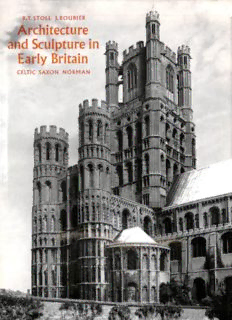
Architecture and Sculpture in Early Britain: Celtic, Saxon, Norman PDF
Preview Architecture and Sculpture in Early Britain: Celtic, Saxon, Norman
Architecture and Sculpture in Early Britain CELTIC SAXON NORMAN ROBERT STOLL PHOTOGRAPHS B Y JEAN RO U BIE R The achievements of the Romanesque style—often referred to in Britain as Saxon and Norman—can in many ways be more fully appreciated in Britain than anywhere else in Europe. No other country can boast such a magnificent series of cathedrals built between the late 1 ith century and 1300: Durham, Winchester, Ely, Peterborough, Norwich, Chichester, Rochester, to name some of the finest. Hardly less imposing are the abbeys and priories now used as parish churches: Southwell, Christchurch, Worksop, Blyth, Romsey and many more. And hundreds of smaller churches survive all over the country, from Kilpeck in Here fordshire to Barfreston in Kent. Now nearly nine hundred years old, they have grown into the English countryside and have become an integral part of British culture and history. To them must be added what remains of pre-Conquest architecture (small in scale but often exquisite in quality) and the contribution of Ireland, with its superb series of Celtic crosses. From these buildings a wealth of sculpture survives, much of it still in situ—tympana, capitals, fonts, decora tive motifs on façades and arches—leading us abruptly into the teeming world of the Romanesque imagi nation : the passion of Christ and His saints inextricably blended with the monsters of a more remote mytho logy. Many of these works, such as the reliefs of the Harrowing of Hell and the Raising of Lazarus at Chichester, are masterpieces comparable with any of later times ; and surviving wall-paintings, though few and mutilated, have the same sombre power. These marvels of medieval art are fully represented in this book in a sequence of over 250 new photo graphs, which capture both the total 1 mpression given by a Romanesque building and the sti ange fascination of its details. Each plateis accompanied by an authori tative commentary which conveys the essential his torical and architectural information. Here is the essence of a style and of an age—an age in which grandeur was combined with delicacy and strength with beauty ; and in which the faith that was moulding medieval Christianity found its first and most com manding expression. on the jacket Ely Cathc Irai, seen froi- K >rth-\\ st With 260 black-and-u photogravure ARCHITECTURE AND SCULPTURE IN EARLY BRITAIN A R C H I T E C T U R E A N D S C U L P T U R E IN EARLY B R IT A IN Celtic Saxon Norman ROBERT STOLL with photographs by Jean Roubier A STUDIO BOOK THE VIKING PRESS • NEW YORK Translated from the German by J. MAXWELL BROWNJOHN BRITANNIA ROMANICA © 1966 BY ANTON SCHROLL & CO., VIENNA ARCHITECTURE AND SCULPTURE IN EARLY BRITAIN THIS EDITION © 1967 BY THAMES AND HUDSON, LONDON PUBLISHED IN 1967 BY THE VIKING PRESS, INC. 625 MADISON AVENUE, NEW YORK, N.Y. 10022 ILLUSTRATIONS PRINTED BY BRAUN ET CIE, MULHOUSE, FRANCE TEXT PRINTED IN GERMANY BY BOSS-DRUCK UND VERLAG, KLEVE BOUND IN HOLLAND BY VAN RIJMENAM, N.V. CONTENTS ARCHITECTURE AND SCULPTURE IN EARLY BRITAIN 7 Scope and Definition 8 The Irish 10 The Anglo-Saxons 13 Christianization and Early Prime 15 Excursus on the Anglo-Saxon Hall 18 The Age of Reform 21 The Age of Transition 24 The Norman Era 26 Norman architecture 30 THE PLATES 35 NOTES ON THE PLATES 277 Kent and Sussex 277 Wessex 286 Mercia 293 Ireland 307 Scotland 320 Northumbria 322 Lindsey and Central England 332 Essex and East Anglia 340 MAP OF BRITAIN 351 INDEX OF PLACE NAMES 352
Description: